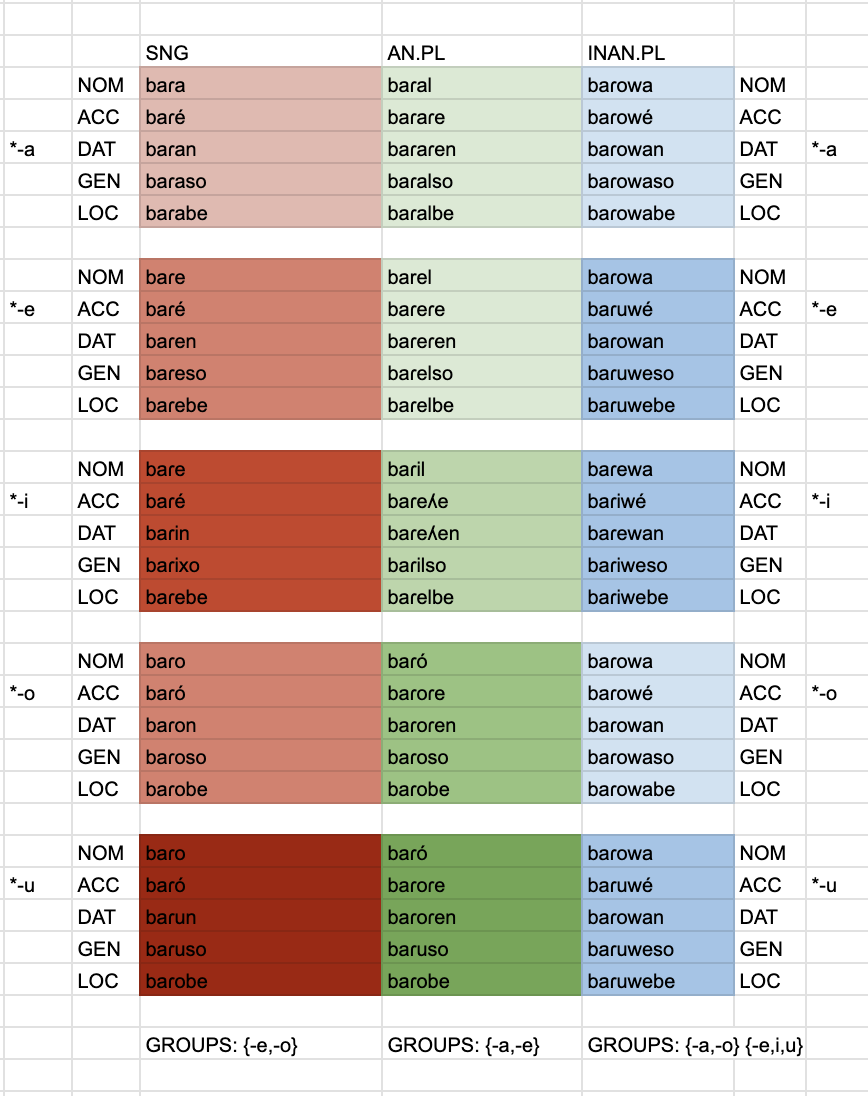Page 1 of 1
Advice on Identifying "Declensions"
Posted: Mon Apr 08, 2024 4:08 pm
by Oxygenman
The below table represents the declension of vowel-final nouns in a WIP conlang (my first, really). I'm looking for advice on how best to organize--to the extent possible--these into "classes." They are organized by proto-vowel endings. An accent mark indicates stress in an unexpected location.
As of right now, from what I can tell, words pattern together differently depending on whether they are singular, animate plural or inanimate plural. It looks like there may be room for some analogy in the -*u GEN.AN.PL to match the -*o declension and the -*a ACC.SNG to match the *-e and -*o patterns. Open to any ideas or other comments/questions.

- Screenshot 2024-04-08 at 3.55.21 PM.png (203.79 KiB) Viewed 943 times
Re: Advice on Identifying "Declensions"
Posted: Mon Apr 08, 2024 4:27 pm
by Ahzoh
Declension "classes" is kind of a concept specific to Indo-European languages and it's mostly becuase of a distinction between "athematic" roots which ended in a consonant and "thematic" roots which involve some vowel like /u/ or /i/ in the case endings.
So like, you'd have one declension class for the athematic roots, which usually manifest as either no vowel plus case endings or /a/ plus case endings (e.g. Latin -as/-s, Old persian -a, -am, -ā), another declension class for roots ending in /i/ plus case endings (e.g. Latin -is, Old Persian -iš, iy), another for roots ending in /u/ plus case endings (e.g. Latin -us, Old Persian -uš, -uv).
So for your language, you could have one declension class that involves Proto -a, another that involves Proto -e. -i, and a third involving Proto -o, -u. Because for each of these categories, the case endings appear similar, especially in the nominative and accusative.
Re: Advice on Identifying "Declensions"
Posted: Mon Apr 08, 2024 5:01 pm
by Travis B.
Going along with what Ahzoh said, do you want to make your language IE-esque, because this kind of system is very IE-esque as a whole? If sure, fine, but then you should think about how else you would want to make your language IE-like. But you should be aware that this is not the only way languages work; e.g. many languages have case-marking in the form of clitics that attach to entire NP's at a time and which only form anything resembling "declensions" due to phonological effects of the clitics attaching to the (usually) final word in the NP.
Re: Advice on Identifying "Declensions"
Posted: Mon Apr 08, 2024 6:17 pm
by Oxygenman
Travis B. wrote: ↑Mon Apr 08, 2024 5:01 pm
[...] many languages have case-marking in the form of clitics that attach to entire NP's at a time and which only form anything resembling "declensions" due to phonological effects of the clitics attaching to the (usually) final word in the NP.
This is actually closer to what I was ultimately trying to do. Maybe a little cliche, but was looking at Basque as inspiration

. Some of the sound changes I set up currently, though, have collapsed the more "agglutinative" proto-language.